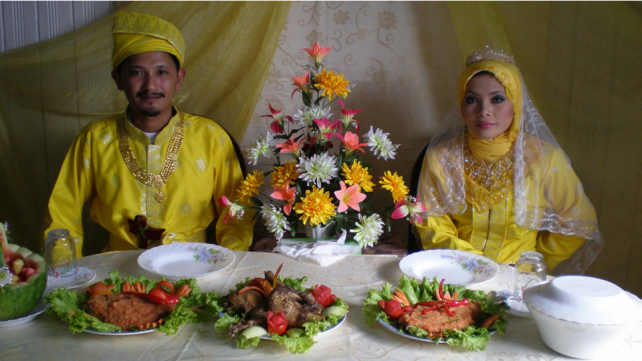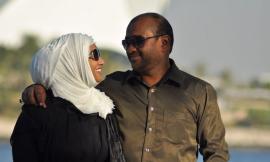
In the Muslim world, marriage customs and traditions vary as much as the colors in a rainbow.
All retain the Islamic obligatory acts, which make a marriage valid, and have other practices, which are individual to their surrounding cultures.
Here are customs from some parts of the Muslim world. Please remember though, that not all Muslim marriage customs are necessarily in line with Islamic values.
India and Pakistan
In South Asia, a marriage is mostly reserved to three days of customs and traditions.
Mehndi: This is the event where you put Mehndi (red color herbal dye, also called Henna) on the bride and groom's hands. Filled with traditional songs and some time dances, it often extends to two days - one day over at the groom's place to put Henna on the groom's hand and the second day over at the bride's house to put Henna on her hands.
Shadi: The actual Islamic wedding, Nikah, is called a Shadi, which is traditionally organized by the bride's side. Groom side arrives at the location in procession called Barat which has its own customs like drums in the front and a shower of coins for those watching it. In the countryside (where 70% of the population lives) almost all village is either in Barat, or waiting for it.
After a Qazi has officiated the marriage with at least two wittnesses observing the consent of the both side. Qazi, literally a judge, is now a days an Imam of a close by mosque which also officiates marriages. After marriage contract has been signed, the Qazi gives a marriage sermon in Arabic and makes dua for maariage. After this couple is declared husband and wife. As soon as dua for wedding is over, all guests stand up hugging the bride and groom, their parents, and their extended family members. Friends of the groom hug him so forcefully that some natural sound effect come out as a result. While this hugging is going on, sweets which include dried dates, almond, and sweets are distributed. Many weddings now take place in a masjid. If it is not in masjid then the groom is lead to masjid where he prays to thank Allah. Some time only guest from out of town are served a meal. But in other marriages many lavish dishes are served to all guests. Shadi ends with Rukhsati. Rukhsati is when groom takes brid to his home. A copy of the Quran is kept above the head of the bride as she is lead to the grooms party waiting to take her. With final advice from parents and lots of tears she says goodbye to them.
Walima: the dinner reception after the marriage is called Walima. This feast is given by the groom's family.
The United Arab Emirates (UAE)
As a tradition in the UAE, the setting of the wedding date marks the beginning of the bride's preparation for her wedding.
Although the groom is also put through a series of preparations, the bride's preparations are naturally more elaborately and are more time consuming.
The bride is lavished with all sorts of traditional oils and perfumes from head to toe. Traditionally, she is not seen for forty days by anyone except for family members as she rests at home in preparation for her wedding day.
During the week which precedes the wedding, traditional music, continuous singing and dancing take place, reflecting the joy shared by the bride's and the groom's family.
Laylat Al Henna (literally, the night of the Henna), which takes place a few days before, is very special night for the bride, since it is a ladies' night only.
On this night, the bride's hands and feet are decorated with henna. The back-to-back feasts and celebrations involve both men and women who usually celebrate separately.
It is followed by actual wedding, Nikah, and Walima, more or less the way it is done all over the Muslim world.
Egypt
Egypt has been exposed to many civilizations, such as the Greek, Roman and Islamic ones. The marriage Customs of the Egyptians make it easy for a couple to get to know one another, for the families meet often.
It starts by the suitor's parents visiting his fiancee's house to get her family approval to complete this marriage and reaching an agreement, which contains two main items: an amount of money paid by the suitor to his fiancee's family to help them prepare the furniture of their daughter and a valuable jewelry gift, called Shabka, given by the suitor to his fiancee. The value of this gift depends on the financial and social levels of the suitor's family.
When the two parties complete the agreement, they fix an appointed date for the engagement party.
When the house of the new family becomes ready, the two families fix a date for the wedding party.
The night before wedding day, the relatives, friends and neighbors get together to celebrate "the Henna Night".
The next day, the marriage contract is signed and registered. After sunset, the wedding party starts and the couple wears their best dresses and jewelry.
Malaysia
In the Malaysian tradition, the bride and groom are treated as "king and queen for a day".
During the betrothal, the pre-wedding meeting between the bride's and the groom's parents, the dowry that will be given to the bride is determined as well as the date of the solemnization.
The berinai (henna application) ceremony is held prior to the wedding. The bride's palms and feet are 'decorated' with the dye from the henna leaves.
Akad Nikah, which is the signing of the contract, is normally presided over by a Kadhi, a religious official of the Syariat (Shariat) Court. A small sum of money called the Mas Kahwin seals the contract.
The recent trend is to hold the solemnization in the mosque as was performed during the Prophet Muhammad's (peace and blessings be upon him) time.








Comments
Add new comment